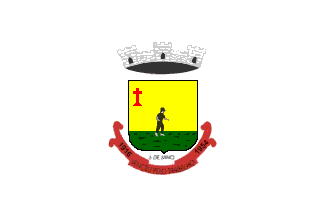 image by Joseph McMillan
image by Joseph McMillan
Last modified: 2012-02-11 by ian macdonald
Keywords: rio grande do sul | três de maio | cross (calvary) | farmer |
Links: FOTW homepage |
search |
disclaimer and copyright |
write us |
mirrors
The flag is white with the coat of arms on the center. The coat of arms is yellow
with a farmer sowing seeds on a green field and a red Calvary cross in the dexter chief.
Source:
www.abase.com.br/tresdemaio/bandeira.htm
Joseph McMillan, 1 August 2002
The municipality of Três de Maio (24,785 inhabitants; 388 sq. km) is
located in northwestern Rio Grande do Sul, 475 km of Porto Alegre. Três de
Maio is known as "Garden Town of Upper Uruguai" and "State Cradle of
Students' Song", being the host of the State Students' Song Festival.
Três de Maio's territory was successively part of the municipalities of Rio
Pardo (1809), Cachoeira do Sul (1819) and Cruz Alta (1839). In 1873, the
territory was transferred to Santo Ângelo, then the seat of
a big
municipality, subsequently split into the municipalities of Palmeria, São
Borja, São Luiz, Santo Ângelo, Ijuí and Santa Rosa.
Municipal Decree No. 104
erected on 10 June 1916 Buricá as the 7th district of Santo Ângelo. Santa
Rosa was made an independent municipality on 14 July 1931, with Buricá as its
2nd district, the new municipality being renamed Santa Rosa de Buricá.
Colonization of Santa Rosa was officially launched by the State on 5 January
1915. There is, however, no precise record of the first colonists, who were
mostly of German, Italian, Polish and Russian origin. In 1940, Buricá had
10,670 inhabitants, 707 of them living in the village of the same name.
Aspiration to municipal emancipation emerged in 1948, which resulted in Law
No. 2,526 of 16 December 1954 creating the new municipality, inaugurated on
28 February 1955. The new municipality was then formed of districts taken
from other municipalities: Três de Maio (Santa Rosa), Ivagaçi (Três Passos),
São José do Inhacorã (Santo Ângelo), and Independência (Santo Ângelo). It
is made today of the five districts of Manchinha, Progresso, Quaraim,
Consolata and Barrinha. The name of the municipality ("3 May") recalls that
the birth date of Nely Dane Longemann, the founder of "Clube Buricá", who
inaugurated the cornerstone of the club house a 3 May. Since 1930, the Buricá
Club
has been the place of a traditional German dance festival organized
for three days and ending on 3 May.
http://www.tresdemaio.com.br/historia.html - Unofficial Três de Maio
website
The coat of arms of Três de Maio is prescribed by Municipal Law
No. 25 of 31 October 1967.
The shield's shape and the crown shall recall
the main origin of the municipality: the Portuguese crown and the German
shield symbolize the merging of the two origins.
The crown is made of
three fortresses, representing the three districts unites to form the
municipality (Três de Maio, São José do Inhacorá, and parts of Independência
and Ivagaçi).
The field, divided in two fields, shows a two-armed cross
recalling the missions.
The yellow field stands for mornings and evenings
lit by the sun.
The green field represents the municipality's fertile soil
with a planter spreading seeds that would produce the basic resource of the
municipality, agriculture.
The red scroll emphasizes the courage and virile
spirit of the inhabitants, surrounding the name of the municipality and
charged with the two main dates of the municipal history - "1916", erection
as a district, and "1954", municipal emancipation -, flanking the municipal
motto, "Venceu pelo trabalho" (Won through work).
http://www.tresdemaio.com.br/bandeira.html - Unofficial Três de Maio
website
Ivan Sache, 14 January 2012